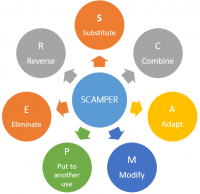Steve Reid
The City of Cape Town runs an annual ideas competition called #YouthStartCT competition. The competition sees over 160 entrants drawn from around Cape Town going through business activation training and pitching the business idea they entered.
I am unsure what entries will be on show in 2019, but if last year is a good gauge to go by, we should see some unique and impactful ideas going through from the original 100 eventually being weaned down to the top 10.
One of the factors that positions the uniqueness of the idea is the level of innovation embraced. Last year saw unique ideas in recycling, social interaction and fashion/design to name a few.
Make no mistake, entrepreneurs and businesses are constantly looking for that product or service that will give them a sustainable edge and advantage. The door to this is mainly through innovation.
So what is innovation?
Innovation is simply doing or making something differently to meet a perceived need or gap in the marketplace. Innovation is not merely doing something differently for difference’s sake. Therefore innovation can happen in any industry that uses a procedure that can be changed.
An example of an innovator is George Washington Carver, (born 1861 died 1943), an American agricultural chemist, agronomist, and experimenter whose development of new products derived from peanuts (groundnuts), sweet potatoes, and soybeans helped revolutionize the agricultural economy of the South.
He actually patented over 300 derivative products from peanuts; among them milk, flour, ink, dyes, plastics, wood stains, soap, linoleum, medicinal oils, and cosmetics!
Generally, innovation involves creative thinking that isn’t from a traditional viewpoint. It can be difficult when you’re very familiar with something to see it in another way. So several techniques have evolved to help you in this process.
The next question is which technique or tool to use to increase your own innovation engagement?
A popular and simple one is found in the acronym SCAMPER
SCAMPER is based on the notion that everything new is a modification of something that already exists. Each letter in the acronym represents a different way you can play with the characteristics of what is challenging you to trigger new ideas:
- S = Substitute
- C = Combine
- A = Adapt
- M = Magnify
- P = Put to Other Uses
- E = Eliminate (or Minify)
- R = Rearrange (or Reverse)

To use the SCAMPER technique, first state the problem you’d like to solve or the idea you’d like to develop. It can be anything: a challenge in your personal life or business; or maybe a product, service or process you want to improve.
It is surprising how many products have been developed using SCAMPER, even if people were not aware of using it as an ideas generation framework.
Look at your mobile phone, it substitutes and combines so many things – phone, camera, torch, GPS, calculator, storage device, etc. Think of how all the apps have added to the functionality of your humble smartphone. Each iteration not only adds to the functionality but apps then adapt, modify and the additional functions that each app adds.
This SCAMPER tool can be used in many ways.
Consider its application in improving sales within your business
Following the SCAMPER recipe, here are a few questions you could ask:
- S (Substitute): “What can I substitute in my selling process?”
- C (Combine): “How can I combine selling with other activities?”
- A (Adapt): “What can I adapt or copy from someone else’s selling process?”
- M (Magnify/ Modify): “What can I magnify or put more emphasis on when selling?”
- P (Put to Other Uses): “How can I put my selling to other uses?”
- E (Eliminate): “What can I eliminate or simplify in my selling process?”
- R (Rearrange): “How can I change, reorder or reverse the way I sell?”
By thinking through the acronym and applying it systematically, one should be able to “uncover” a few key ways to improve the products, services or processes within your business.
Here are examples applied within Industry and well known businesses.
- A mobile phone was combined with a camera and then an MP3 player.
- The roll-on deodorant was an idea adapted from the ballpoint pen.
- Restaurants that offer all you can eat have maximized their proposition.
- A low cost airline like SAFAIR has minimized (or eliminated) many elements of service.
- De Beers put industrial diamonds to other use when they launched engagement rings.
- Dell Computers and Amazon eliminated the intermediary.
- MacDonald’s rearranged the conventional restaurant by getting customers to pay first and then eat.
I think the magic of this process is that it can help us take our every day, ordinary and sometimes mundane world…….and transform it into value adding products, services and ideas through thinking and acting innovatively.
Steve is the manager of False Bay College’s Centre For Entrepreneurship/ Rapid Incubator. Their mission is to grow resilient, innovative youth enterprises.
The CFE/RI will be hosting an information session in February for those keen to start their entrepreneurial journey with the support of an incubator.
Those wanting to know more may contact 021-2011215 for more information or go to their website www.falsebayincubate.co.za


